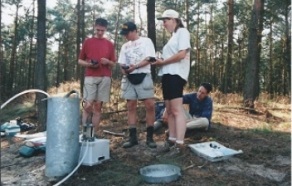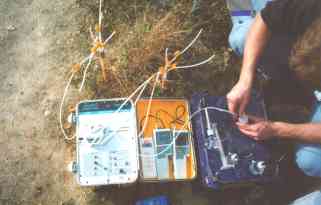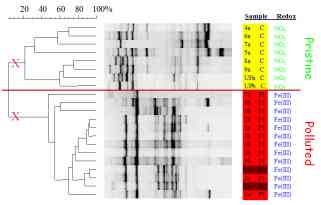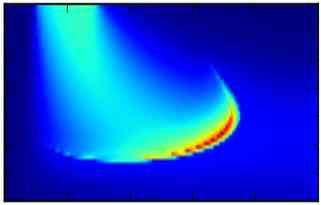Reactive and pollutant transport
Theme leader: Dr. Boris van Breukelen
The water cycle drives the flow of fresh water and its chemical constituents through the terrestrial system.
On its way the water's chemical composition changes due to biogeochemical reactions such as mineral dissolution/precipitation, ion-exchange, and redox processes, as well as by evaporation and mixing with other water sources.
Thus, both transport and reactive processes control the spatial-temporal dynamics of water quality.
The natural evolution of the water's chemical composition may become affected by diffuse (fertilizers and pesticides used in agriculture) and point-source pollution (chemicals released at industrial sites).
Knowledge of reactive transport processes is also a prerequisite for the assessment and optimization of such widely used aquifer technologies as monitored natural attenuation of pollutants (MNA), aquifer storage and recovery (ASR), aquifer thermal energy storage (ATES), subsurface iron and arsenic removal (SIR/SAR), and carbon capture and storage (CCS).
The overall aim of the Group's reactive and pollutant transport research is to improve our understanding and prediction of natural and human-induced water quality dynamics through the quantitative study of the governing reactive transport processes and controlling factors.
The Group combines field research with laboratory (batch, column) experiments and reactive transport modeling (RTM).
In particular use is made of PHREEQC, PHAST (PHREEQC coupled to HST3D), PHT3D (PHREEQC coupled to MODFLOW/MT3DMS), and (recently) the Hydrogeosphere model for catchment-scale modeling.
In addition, these are combined with microbiological, isotope hydrological, and age dating techniques.
Current Projects
Model-assisted interpretation of compound-specific stable isotope analysis (CSIA) data in catchments
PhD project: Stefanie Lutz
Duration: 2011-2014
Funding: 7th Framework Programme of the European Union (Marie Curie Initial Training Network CSI:ENVIRONMENT, contract number PITN-GA-2010-264329)
Collaborators:
Model-assisted interpretation of compound-specific stable isotope analysis (CSIA) data in polluted aquifers
PhD project: Héloïse Thouement
Duration: 2012-2015
Funding: 7th Framework Programme of the European Union (Marie Curie Initial Training Network CSI:ENVIRONMENT, contract number PITN-GA-2010-264329)
Collaborators:
- B.M. van Breukelen - VU University
- Tomasz Kuder - the University of Oklahoma
- Ivonne Nijenhuis - Helmholtz Centre of Environmental Research - UFZ
Duration: 2011-2013
Funding: Environmental Security Technology Certification Program (ESTCP) project ER-201029
Researchers and Collaborators:
Related Projects
Sustainable systems for underground storage of drinking water
PhD project: Andreas Antoniou
Duration: 2009-2013
Funding: TTIW Programme Register 'Interaction with Natural Systems'.
Effects of aquifer thermal energy storage (ATES) on chemical and microbiological groundwater quality
PhD project: Matthijs Bonte
Duration: 2009-2013
Funding: Joint Research Program of the united Dutch water companies
Aquifer Storage and Recovery as a tool for self-sufficient fresh water supply
PhD project: Koen Zuurbier
Duration: 2010-2014
Funding: Knowledge for Climate
Numerical modeling of coupled physico-chemical processes during and following CO2 storage in saline aquifers and depleted hydrocarbon reservoirs
PhD project: Zaman ZiabakhshGanj
Duration: March 2011- November 2014
Funding: Dutch national R&D programme on CO2 capture, transport and storage (CATO-2)
Associated Collaborative Projects
External PhD project: Moshiur Rahman (TU Delft; NWO WOTRO)
Collaborators:
- M. Bakker - TU Delft
- K. Matin Ahmed - Dhaka University
- H. Savenije - TU Delft
- D. van Halem - TU Delft
- B.M. van Breukelen - VU University
Enhanced in situ biodenitrification for nitrate-polluted groundwater
External PhD project: Paula Rodríguez-Escales (d D'ENGINY biorem, Autonomous University of Barcelona)
Collaborators:
Project description:
Groundwater pollution by nitrate is an important environmental problem.
Enhanced in-situ biodenitrification is a clean and economical technology that allows remediating nitrate-polluted groundwater.
In this context, development of reactive transport models (RTM) in order to predict rates of in situ biodenitrification is a useful tool to design and monitor the performance of this technology.
The main objective of this project is the development of models of enhanced in-situ biodenitrification at different scales, from batch to field scale.
The models involve microbiological processes, main geochemical interactions with aquifer and isotopic fractionation during denitrification.
Age dating of young groundwaters
External project TNO/Deltares: Exploring the use of age tracers (3h/3He, 39Ar, 85Kr, CFSs, SF6) to derive travel time distributions and explain groundwater quality trends
Duration: 2009-present
Funding: TNO co-financing program, Vitens N.V., EU FPVII Aquaterra
Collaborators:
- H.P. Broers - VU University/ Deltares / TNO
- A. Visser - Lawrence Livermore National Lab, Livermore, USA
- R. Purtschert - University of Bern, Switzerland
- R. Heerdink - Deltares
- A. Marsman - Deltares
- M. de Jonge - VItens N.V.
Recently finished projects
Hydrogeochemical studies on the fate of manure derived N in groundwater
External PhD project: Yanchun Zhang
Duration: 2006-2012
Funding: Dutch organisation for Fundamental Research (NWO)
Collaborators:
- H.P. Broers - VU University/ Deltares / TNO
- C. Slomp - Utrecht University
- P. van Cappellen - University of Waterloo, Canada
- H. Prommer - CSIRO, Australia
Key publications
An overview presentation of current RTM research by the Group was presented in the following Boussinesq lecture by B. van Breukelen
Reactive transport modeling
- Karlsen, R.H., Smits, F. J. C., Stuyfzand, P.J., Olsthoorn, T.N., van Breukelen, B.M., 2012. A Post audit and inverse modeling in reactive transport: 50 years of artificial recharge in the Amsterdam water supply dunes. Journal of Hydrology 454-455: 7-25.
- van Breukelen, B.M., Griffioen, J., 2004. Biogeochemical processes at the fringe of a landfill leachate pollution plume: potential for dissolved organic carbon, Fe(II), Mn(II), NH4 and CH4 oxidation. Journal of Contaminant Hydrology 73(1-4): 181-205.
- van Breukelen, B.M., Griffioen, J., Röling, W.F.M., Van Verseveld, H.W., 2004. Reactive transport modelling of biogeochemical processes and carbon isotope geochemistry inside a landfill leachate plume. Journal of Contaminant Hydrology 70(3-4): 249-269.
- van Breukelen, B.M., Röling, W.F.M., Groen, J., Griffioen, J., Van Verseveld, H.W., 2003. Biogeochemistry and isotope geochemistry of a landfill leachate plume. Journal of Contaminant Hydrology 65(3-4): 245-268.
- van Breukelen, B.M., Appelo, C.A.J., Olsthoorn, T.N., 1998. Hydrogeochemical transport modeling of 24 years of Rhine water infiltration in the dunes of the Amsterdam water supply. Journal of Hydrology 209(1-4): 281-296.
Reactive transport modeling of isotope fractionation processes
- Lutz, S. R., van Meerveld, H. J., Waterloo, M. J., Broers, H. P., and van Breukelen, B. M. (2013) A model-based assessment of the potential use of compound-specific stable isotope analysis in river monitoring of diffuse pesticide pollution, Hydrol. Earth Syst. Sci., 17, 4505-4524, doi:10.5194/hess-17-4505-2013.
- van Breukelen, B.M., Rolle, M., 2012. Transverse hydrodynamic dispersion effects on isotope signals in groundwater chlorinated solvents' plumes. Environmental Science and Technology 46: 7700-7708.
- Hunkeler, D., van Breukelen, B.M., Elsner, M., 2009. Modeling chlorine isotope trends during sequential transformation of chlorinated ethenes. Environmental Science and Technology 43(17): 6750-6756.
- van Breukelen, B.M., Prommer, H., 2008. Beyond the Rayleigh equation: reactive transport modeling of isotope fractionation effects to improve quantification of biodegradation. Environmental Science and Technology 42(7): 2457-2463.
- van Breukelen, B.M., Hunkeler, D., Volkering, F., 2005. Quantification of sequential chlorinated ethene degradation by use of a reactive transport model incorporating isotope fractionation. Environmental Science and Technology 39(11): 4189-4197.
Compound-specific stable isotope analysis (CSIA)
- van Breukelen, B.M., 2007b. Quantifying the degradation and dilution contribution to natural attenuation of contaminants by means of an open system Rayleigh equation. Environmental Science and Technology 41(14): 4980-4985.
- van Breukelen, B.M., 2007a. Extending the Rayleigh equation to allow competing isotope fractionating pathways to improve quantification of biodegradation. Environmental Science and Technology 41(11): 4004-4010.
- Mancini, S.A., Lacrampe-Couloume, G., Jonker, H., van Breukelen, B.M., Groen, J., Volkering, F., Lollar, B.S., 2002. Hydrogen isotopic enrichment: An indicator of biodegradation at a petroleum hydrocarbon contaminated field site. Environmental Science and Technology 36(11): 2464-2470.
Age dating and monitoring reactive processes in aquifers
- Zhang, Y.-C., Slomp, C.P., Van Cappellen, P., Broers, H.P., Passier, H.F., Böttcher, M.E., Omoregie, E.O., Lloyd, J.R., Polya, D.A. (2010). Denitrification coupled to pyrite oxidation in a sandy aquifer: Stable isotopic and microbiological evidence. Water-Rock Interaction - Proceedings of the 13th International Conference on Water-Rock Interaction, WRI-13, pp. 975-978.
- Visser, A. et al. (2009) Comparison of methods for the detection and extrapolation of trends in groundwater quality. Journal of Environmental Monitoring 11:2030-2043.
- Zhang Y.C., C.P. Slomp, H.P. Broers, H.F. Passier and Ph. Van Cappellen (2009) Denitrification coupled to pyrite oxidation and changes in groundwater quality in a shallow sandy aquifer. Geochemica et Cosmochimica Acta 73:6716-6726.
- Visser, A. H.P. Broers, R. Heerdink and M.F.P. Bierkens (2009) Trends in pollutant concentrations in relation to time of recharge and reactive transport at the groundwater body scale. Journal of Hydrology, 369:427-439.
- Visser, A. J.D. Schaap, H.P. Broers and M.F.P. Bierkens (2009). Degassing of 3H/3He, CFCs and SF6 by denitrification: measurements and two-phase transport simulations. Journal of Contaminant Hydrology (103)3-4:206-218.
- Broers, H.P., Visser A., J.C. Chilton and M.E. Stuart (2009) Chapter 4.2 Assessing and aggregating trends in groundwater quality. In: Groundwater Monitoring. Quevauviller P., Fouillac A.M., Grath J. and Ward, R. (eds). John Wiley & sons, p.189-206.
- Geer F.C., M.F.P. Bierkens and H.P. Broers (2008) Groundwater monitoring strategies. Encyclopedia of Hydrological Sciences. DOI: 10.1002/0470848944.hsa316.
- Visser, A., H.P. Broers, & M.F.P. Bierkens (2008) Dating degassed groundwater with 3H/3He. Water Resources Research 43(10), W10434.
- Visser, A., H.P. Broers, & M.F.P. Bierkens (2007) Demonstrating trend reversal in groundwater quality in relation to time of recharge determined by 3H/3He dating. Environmental Pollution 148(3): 797-807.
- Broers, H.P. , A. Marsman, F. van Geer, B. van der Grift and A. Visser (2007) Improving the prediction of future groundwater quality analyzing concentration-depth profiles. International Conference on Water Rock Interaction, July 31th-August 5th 2007, Kunming, China.
- Broers, H.P. & F.C. van Geer (2005) Evaluating monitoring strategies at phreatic well fields. Groundwater 43 (6) p. 850-862.
- Broers, H.P. & B. van der Grift (2004) Regional monitoring of temporal changes in groundwater quality. Journal of Hydrology 296:192-220.
- Broers, H.P. (2004) The spatial distribution of groundwater age for different geohydrological situations in The Netherlands: implications for groundwater quality monitoring at the regional scale. Journal of Hydrology 299: 84-106.
- Broers, H.P. (2004) Nitrate Reduction and Pyrite Oxidation in the Netherlands. Chapter 14 in: Nitrate in groundwaters IAH Selected papers on hydrogeology., Eds. L.Razowska-Jaworek & A. Sadurski. p. 141-149. Balkema Publishers, Leiden, The Netherlands.
Last modified: Mon Dec 28 14:51:35 CET 2015






